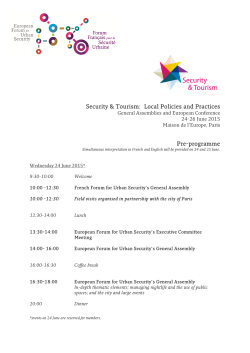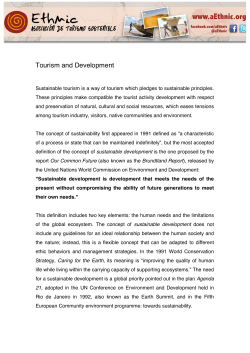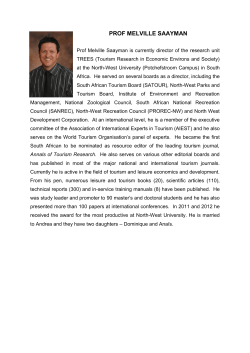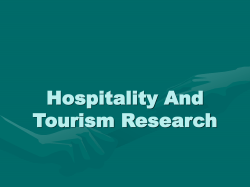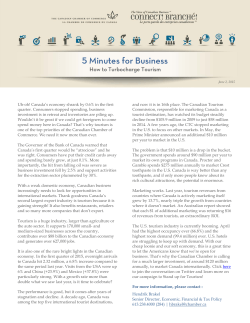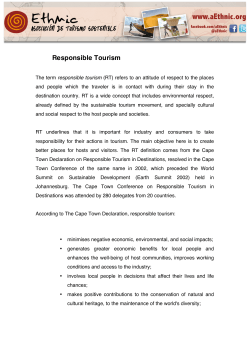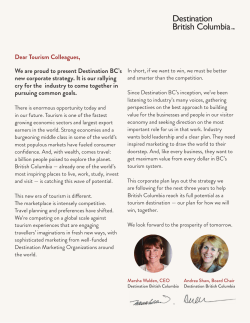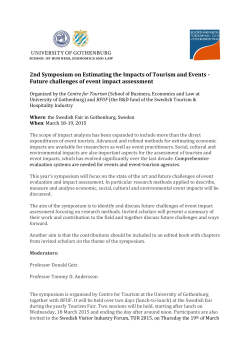
Developing KnowledgeâBased Travel Advisor Systems:
38 Chapter 3 Developing Knowledge‐Based Travel Advisor Systems: A Case Study Dietmar Jannach Technische Universität Dortmund, Germany Markus Zanker University Klagenfurt, Austria Markus Jessenitschnig University Klagenfurt, Austria AbstrAct In the domain of travel and tourism, recommender systems have proven to be valuable tools for supporting potential customers during the decision making process. In contrast to other domains, however, travel recommendation systems must not only include extensive knowledge about catalogued items but also require interactive elicitation of customer requirements. As a consequence, such systems often become highly-interactive and personalized Web applications, whose development can be costly and time-consuming. The authors see these factors as major obstacles to the widespread adoption of this type of recommender system in particular with respect to small and medium-sized companies and e-tourism platforms. The “Vibe virtual spa advisor” presented in this chapter is an example of a recommender system offering such high level interaction. It has been built with the help of AdVisor suite, an off-the-shelf knowledge-based and domain-independent framework for the rapid development of advisory applications. The chapter discusses how development costs can be reduced by using a framework that supports graphical domain modeling, domain-independent recommendation algorithms and semi-automated generation of production quality web applications. The authors also report on practical experiences and give an outlook on future work and opportunities in the domain of travel recommendation. DOI: 10.4018/978-1-60566-818-5.ch003 Copyright © 2010, IGI Global. Copying or distributing in print or electronic forms without written permission of IGI Global is prohibited. Developing Knowledge-Based Travel Advisor Systems IntroductIon The travel and tourism sector is not only a leading industry with substantial growth rates, but is also a sector in which the web already forms the primary source of information. Today, people searching for travel destinations or planning a trip typically consult a web-based information system first. Furthermore, recent studies (such as those conducted by the European Travel Commission) show that the share of customers that actually book their travel arrangements online is constantly growing, which in turn means that sales opportunities can be easily missed if appropriate electronic online services are not provided on travel agency web sites or e-tourism platforms. Consequently, the online market in the travel and tourism domain has become highly competitive, supporting a vast number of information and booking platforms. However this has also resulted in the fact that online service providers are finding it increasingly harder to attract (new) customers to their sites, and more importantly, to turn these potential customers into buyers; see (Werthner & Ricci, 2004) for a detailed discussion on the role of e-commerce for tourism industry. In this context, Recommender Systems can be seen as a promising opportunity to add value to online services that can help to differentiate a platform from its competition. Such systems have already been successfully deployed in various domains and have proven to be valuable tools for coping with information overload and for guiding online customers through the decision-making and purchase process. Although there has been extensive research into recommender systems over the last decade especially concerning community-based approaches – see, e.g., (Adomavicius & Tuzhilin, 2005) for an overview – the tourism domain shows some specific particularities. First, most travel recommender applications are content or knowledge based (Burke, 2000) i.e., the system possesses deep knowledge of the catalogued items; and can determine that the alternatives are simply not viable. For example, community-based approaches require a minimal size of the user community, which is hard for small- and medium sized etourism platforms to achieve. In addition, without a detailed buying history for each customer, customers with similar preferences and tastes cannot be identified by collaborative approaches. However, following a content-based approach also means that the customer’s travel preferences have to be elicited interactively using a complex elicitation, as it must support a heterogeneous user community including first-time visitors, occasional users, as well as experienced travelers who have very concrete and detailed requirements. Consequently, the user interface for such a system should be conversational, adaptive and personalized in order to be suitable for all these different user groups, see (Bridge, 2000), (Carenini, Smith & Poole, 2003) and (Thompson et al., 2004). Finally, there are also special requirements with respect to the generation of proposals, i.e. the recommendation algorithms. The most prominent content-based systems utilize Case-Based Reasoning, see e.g., (McSherry, 2005; Ricci & Del Messier, 2004; Ricci & Werthner, 2002), as well as Critiquing (Reilly et al., 2005) techniques. Utility functions for ranking or constraint-based filtering are also commonly used (Burke, 2000), either alone or in combination with other recommendation techniques. Furthermore, with respect to proposal generation algorithms, there are other specific problems to be solved in the travel and tourism domain such as the consistent “bundling” of several items, cf. (Ricci, 2002), which shall be discussed in a later section. Compared with self-adapting collaborative systems, the well-known drawback of all these knowledge-intensive approaches is that the required domain expertise, such as similarity functions, has to be formalized in an initial modeling and formalization phase, and has to be maintained and updated on a regular basis. 39 14 more pages are available in the full version of this document, which may be purchased using the "Add to Cart" button on the publisher's webpage: www.igi-global.com/chapter/developing-knowledge-based-traveladvisor/37758 Related Content The Reflections of the Recent Global Economic Crisis on the Turkish Tourism Sector: The Sample of Fairy Chimneys Area (Cappadocia) Ali Ylmaz and Semra Gunay Akta (2015). Hospitality, Travel, and Tourism: Concepts, Methodologies, Tools, and Applications (pp. 934-944). www.irma-international.org/chapter/the-reflections-of-the-recent-global-economic-crisis-on-theturkish-tourism-sector/119259/ Gap Analysis and Infrastructure Requirement for Tourism Development in the State of West Bengal: Evidence from Bishnupur, West Bengal, India Dillip Kumar Das and Nilanjan Ray (2015). Hospitality, Travel, and Tourism: Concepts, Methodologies, Tools, and Applications (pp. 186-197). www.irma-international.org/chapter/gap-analysis-and-infrastructure-requirement-for-tourismdevelopment-in-the-state-of-west-bengal/119214/ Developing Patterns for Thinking About City Marketing Initiatives José-Rodrigo Córdoba, Nicolas Jullien and Jocelyne Trémenbert (2009). Information Communication Technologies and City Marketing: Digital Opportunities for Cities Around the World (pp. 246-263). www.irma-international.org/chapter/developing-patterns-thinking-city-marketing/22582/ Collaborative Commerce and the Hotel Industry Michelle Rowe and Alfred Ogle (2007). Information and Communication Technologies in Support of the Tourism Industry (pp. 242-259). www.irma-international.org/chapter/collaborative-commerce-hotel-industry/22532/ The Implementation of Rural Heritage Measures in Ukraine: Opportunities and Directions Serhiy Moroz (2015). Hospitality, Travel, and Tourism: Concepts, Methodologies, Tools, and Applications (pp. 529-539). www.irma-international.org/chapter/the-implementation-of-rural-heritage-measures-inukraine/119235/
© Copyright 2025
